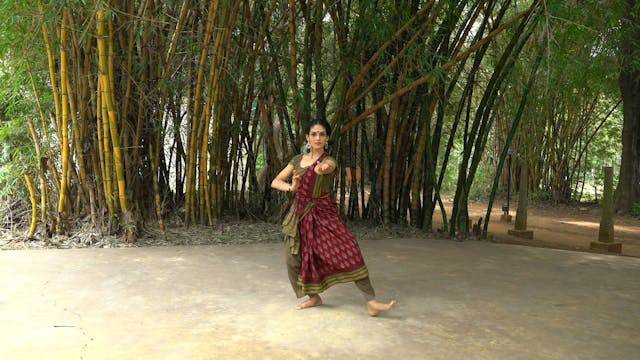Kuditta Mettadavu: Variations
Playlist 31
•
2m 33s
The Kuditta mettadavu, named so because of the combination of a small jump and then the dropping of the heel, is usually done with hands to the side and then a small cross at the wrists.
These variations, continue with the same movement of the feet while changing the torso and arm movements.
- Ensure you are comfortable in all speeds in the first Kuditta mettadavu, before progressing to the variations.
- Practise only the first speed for a while until you are able to understand the torso movements.
- Think of the various bends you have learned so far and observe the plane that the bend is happening in.
- Try not to go up and down, and stay low for the entire time.
- Lift your heels completely each time and make sure both feet snatch up onto the toes simultaneously.
Try to go down instead of hopping up each time you snatch onto your heels.
Keep dropping your tailbone and pushing your thighs back.
When you bend to the side, try not to have any form of a forward bend.
If you are unable to hold your back upright, follow the Araimandi / Muzhumandi exercise series and do more leg strength.
Up Next in Playlist 31
-
Teermana Adavu 1
The Theermana or Makutadavu, is placed at the end of a Korwe or Jathi in specific rhythmic patterns, to create an ending.
The leg is either placed outstretched directly in front or at a diagonal of 45 degrees. The foot is flexed and the heel strikes the floor. In the Raadha Kalpa method we begi...
-
Theermana Adavu 2
The Theermana or Makutadavu, is placed at the end of a Korwe or Jathi in specific rhythmic patterns, to create an ending.
The leg is either placed outstretched directly in front or at a diagonal of 45 degrees. The foot is flexed and the heel strikes the floor. In the Raadha Kalpa method we begi...
-
Theermana Adavu 3, variation
The Theermana or Makutadavu, is placed at the end of a Korwe or Jathi in specific rhythmic patterns, to create an ending.
The leg is either placed outstretched directly in front or at a diagonal of 45 degrees. The foot is flexed and the heel strikes the floor. In the Raadha Kalpa method we begi...


